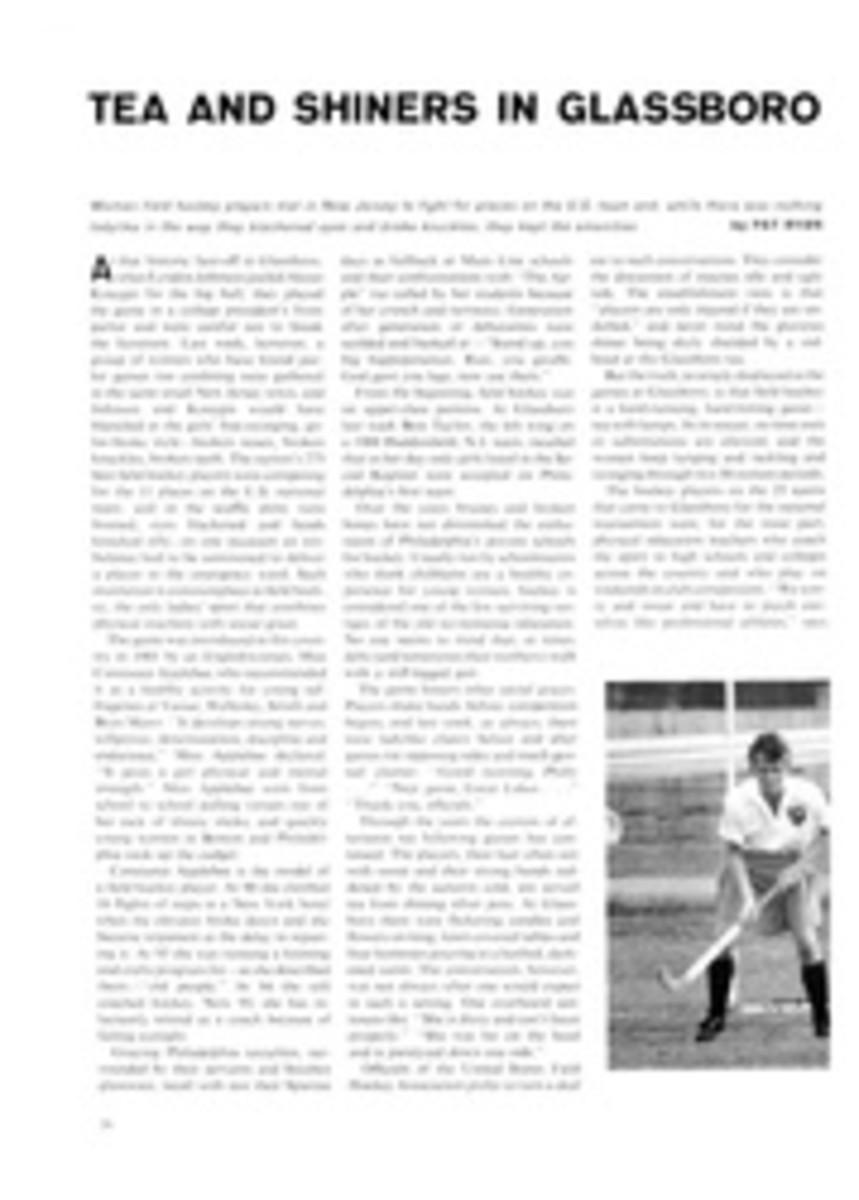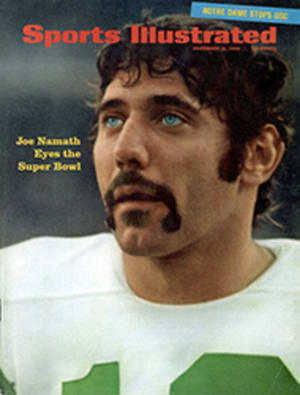
TEA AND SHINERS IN GLASSBORO
At that historic face-off in Glassboro, when Lyndon Johnson jostled Alexei Kosygin for the big ball, they played the game in a college president's front parlor and were careful not to break the furniture. Last week, however, a group of women who have found parlor games too confining were gathered in the same small New Jersey town, and Johnson and Kosygin would have blanched at the girls' free-swinging, go-for-broke style—broken noses, broken knuckles, broken teeth. The nation's 275 best field hockey players were competing for the 11 places on the U.S. national team, and in the scuffle shins were bruised, eyes blackened and heads knocked silly; on one occasion an ambulance had to be summoned to deliver a player to the emergency ward. Such mutilation is commonplace in field hockey, the only ladies' sport that combines physical mayhem with social grace.
The game was introduced in this country in 1901 by an Englishwoman, Miss Constance Applebee, who recommended it as a healthy activity for young suffragettes at Vassar, Wellesley, Smith and Bryn Mawr. "It develops strong nerves, willpower, determination, discipline and endurance," Miss Applebee declared. "It gives a girl physical and mental strength." Miss Applebee went from school to school pulling virtues out of her sack of shinny sticks, and quickly young women in Boston and Philadelphia took up the cudgel.
Constance Applebee is the model of a field hockey player. At 90 she climbed 16 flights of steps in a New York hotel when the elevator broke down and she became impatient at the delay in repairing it. At 93 she was running a knitting and crafts program for—as she described them—"old people." At 94 she still coached hockey. Now 95, she has reluctantly retired as a coach because of failing eyesight.
Graying Philadelphia socialites, surrounded by their servants and Steuben glassware, recall with zest their Spartan days as fullback at Main Line schools and their confrontations with "The Apple" (so called by her students because of her crunch and tartness). Generation after generation of debutantes were scolded and barked at—"Stand up, you big hippopotamus. Run, you giraffe. God gave you legs, now use them."
From the beginning, field hockey was an upper-class pastime. At Glassboro last week Bess Taylor, the left wing on a 1908 Haddonfield, N.J. team, recalled that in her day only girls listed in the Social Register were accepted on Philadelphia's first team.
Over the years bruises and broken bones have not diminished the enthusiasm of Philadelphia's private schools for hockey. Usually run by schoolmarms who think chilblains are a healthy experience for young women, hockey is considered one of the few surviving vestiges of the old no-nonsense education. No one seems to mind that, at times, debs (and sometimes their mothers) walk with a stiff-legged gait.
The game fosters other social graces. Players shake hands before competition begins, and last week, as always, there were ladylike cheers before and after games for opposing sides and much genteel chatter: "Good morning, Philly..." "Nice game, Great Lakes..." "Thank you, officials."
Through the years the custom of afternoon tea following games has continued. The players, their hair often wet with sweat and their strong hands reddened by the autumn cold, are served tea from shining silver pots. At Glassboro there were flickering candles and flowers on long, linen-covered tables and four hostesses pouring in a hushed, darkened room. The conversation, however, was not always what one would expect in such a setting. One overheard sentences like. "She is dizzy and can't focus properly." "She was hit on the head and is paralyzed down one side."
Officials of the United States Field Hockey Association prefer to turn a deaf ear to such conversations. They consider the discussion of injuries idle and ugly talk. The establishment view is that "players are only injured if they are unskilled," and never mind the glorious shiner being shyly shielded by a redhead at the Glassboro tea.
But the truth, as amply displayed in the games at Glassboro, is that field hockey is a hard-running, hard-hitting game—tea with lumps. As in soccer, no time outs or substitutions are allowed, and the women keep lunging and tackling and swinging through two 30-minute periods.
The hockey players on the 25 teams that came to Glassboro for the national tournament were, for the most part, physical education teachers who coach the sport in high schools and colleges across the country and who play on weekends in club competition. "We worry and sweat and have to psych ourselves like professional athletes," says Faye Bardman, a member of the 1967 national team and the coach at Penn. "This is an entirely different kind of hockey than what my team plays at Penn. The girls there go out for hockey so they won't get fat."
Few socialites reach national team caliber—most of the players in the tournament first took up hockey in public high schools—though this does not mean there has been any break with hockey's aristocratic past. One competitor at Glassboro was overheard complaining about the minuscule coverage of the event in The New York Times: "It must be a Democratic newspaper," she huffed.
In age the players ranged from phys. ed. college students of 19 or 20 to matrons in their 50s. In the 1967 tournament the New Atlantic team had four players over 45. It was referred to as the Medicare Squad. ("I've had the grace to retire," one middle-aged Bostonian said acidly when the subject of old hockey players came up.)
Some sections of the country sent one team to Glassboro, some two and Philadelphia, the stronghold of hockey (its first team has only once been beaten in a tournament by another U.S. squad), sent five. Ten of the 11 players on the 1967 national team were from the Philadelphia area or had once lived there.
When the ladies got down to the hacking and the slashing last Thursday—Thanksgiving Day, mind you—Philadelphia appeared still to have a grip on the sport. In a frigid downpour, from 8:30 in the morning until dark, women clad only in cotton blouses and skirts charged up and down muddy fields. The selectors of the national team, seven formidable ladies bundled like Green Bay fans, strode the sidelines eying talent. In this tournament it mattered not if you won or lost, but how you played, for the U.S. team is picked on an individual basis. By Thursday evening Philadelphia teams had won three of four games against squads from other parts of the country.
But just when Philadelphia seemed supreme it suffered a stunning upset. On Friday afternoon its first team met a touring Dutch squad in what amounted to an exhibition game. The Dutch side included only four members of the Netherlands national team; the other seven players were inexperienced and had been sent on tour to become more seasoned. Philadelphia Captain Vonnie Gros was confident of winning. For the first half the teams played skillful, free-flowing hockey, the finest to be seen at the tournament. Neither side scored. Early in the second half, however, the Dutch gained two quick goals. The Philadelphians fell apart and were wiped out 6-0.
Then on Saturday afternoon the best Philadelphia players had difficulty winning a match against a weak Great Lakes eleven. "Some of those Philadelphia girls are looking old," a longtime coach remarked. The selectors began to look elsewhere for candidates with the stickwork, coordination, speed, innate aggressiveness and attitude needed in international play. From the back of a dump truck they peered over the playing fields. Ultimately, however, they chose seven players from the Philadelphia area to provide the core of the national squad. An eighth player was trained in Philadelphia schools. The other three named to the team are, significantly, young college students. But the new team scarcely lacks experience. The 11 women have played hockey for a total of 137 years, or about 12½ years per person.
As usual in national and international field hockey tournaments, no overall champion team was named. The women have never permitted titles or trophies because they believe such awards would cause ill feeling. "It might destroy the friendly atmosphere between countries," explained Grace Robertson, president of the USFHA. It is a noble principle—one that is also part of the code for summit conferences.
TWO PHOTOS
Veteran hockeyists of the New Atlantic region staunchly defend goal against a Mideast attacker; at tea a young warrior displays mark of battle.

